Pentax K200D Camera Experience
One of the best things about the Pentax K200D is that it’s quick. It powers up promptly and focuses quickly. Exposure is very impressive — both with and without flash. The 16-segment metering works very well with auto exposure and scene modes. The flash performs nicely and only pops up when you press the flash button. I really dislike when a camera decides to pop up the flash when I’m not expecting it. I like to make that decision. When you do want to use the flash, you just push the “UP” flash button and the flash pops right up.
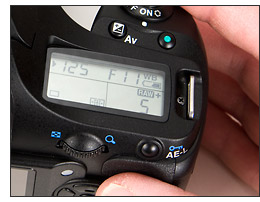 There’s always a learning curve with a new camera. But I had a hard time locating some of the most basic and important camera functions on the K200D. It took some searching to figure out how to change the ISO, and changing the aperture in manual exposure mode is new and awkward for me. You have to hold down the Av button and spin the e-dial at the same time (see photo – right). Single dial exposure control is standard on consumer-level DSLRs, but coming from a professional camera, it was hard for me to figure out and get used to.
There’s always a learning curve with a new camera. But I had a hard time locating some of the most basic and important camera functions on the K200D. It took some searching to figure out how to change the ISO, and changing the aperture in manual exposure mode is new and awkward for me. You have to hold down the Av button and spin the e-dial at the same time (see photo – right). Single dial exposure control is standard on consumer-level DSLRs, but coming from a professional camera, it was hard for me to figure out and get used to.
The K200D’s Digital Preview function also seems weird to me. There are both Optical and Digital Preview options, accessed by a toggle switch surrounding the shutter release button. Pushing the switch clockwise will preview the image on the LCD monitor. You can then save the preview by hitting the function (Fn) button, if you want. I don’t really understand the point, though. Why not just take a picture and look at it on the monitor?
I typically left the K200D’s Shake Reduction system on to help combat image blur from camera shake. As mentioned in the Features section of this review, the Pentax Shake Reduction image stabilization system moves the image sensor instead of lens elements. With optical IS systems you can see movement in the lens as the image stabilization compensates for camera movement. But with in-camera IS you can’t see the effect because it’s happening in the camera instead of the lens. Each system has its pros and cons and some people prefer one over the other. I think the in-camera Shake Reduction is great. The main reason is that you don’t have to buy special image-stabilized lenses. You buy the camera body and you’ve got it in every lens. Also, when image stabilization is built into the lens the movement can be very noticeable and it has actually made me nauseous in the past.
Auto focus with the 18-55mm kit lens is very loud, with a high-pitched “sweee-sweee” sound. I guess I’ve been spoiled by silent auto focus lenses. The 18-55mm lens also has a slow maximum aperture – f/3.5 at the wide end and f/5.6 at the telephoto end. The widest setting, 18mm, looks more like 27mm due to the 1.5x digital conversion. But the lens was nice and sharp and gets the job done – especially for beginners. If you want something better, both the Pentax SMC-DA 16-50mm F2.8 ED/AL (IF) SDM and the SMCP-DA 16-45mm f/4.0 ED/AL lenses are excellent and a great deal at about half the price of comparable Nikon or Canon optics – not to mention you don’t need to worry about the extra weight or cost of image stabilization since it’s built into the K200D body
A nice feature, which I haven’t seen on any other digital SLR, is the K200D’s ability to use regular AA batteries. Don’t get me wrong, I’m all for proprietary rechargeable lithium-ion batteries, but I’m also big on back-ups. If you forget to charge a proprietary rechargeable battery (I’ve done it done many times) and don’t have an extra, you’re in big trouble. With the K200D you can go into just about any store and buy a set of replacement AA batteries. The Energizer Lithium AA batteries have performed very well. I’ve been using the camera for several weeks and the batteries are still at full power
Image Quality
Pentax K200D’s image quality is very impressive, rivaling other cameras that cost much more. Color from the Pentax K200D is typically right on — maybe a bit oversaturated but the colors are nice and vibrant. And unlike some digital SLRs, colors do not degrade rapidly when moving up the ISO ladder. I shot some photos at ISO 1600, the highest ISO setting, and was amazed at the color, detail and minimal noise. Even at ISO 1600, the K200D produces a sharp, detailed, and very usable image.
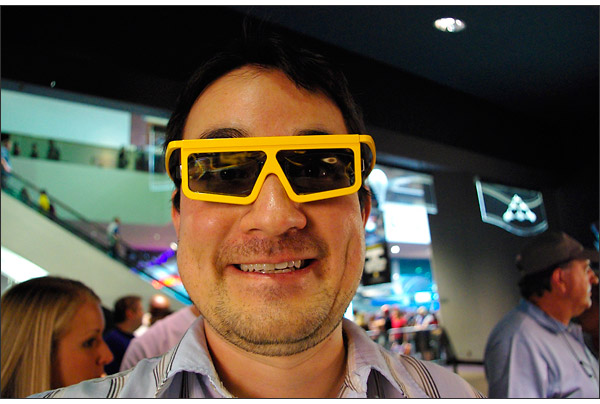
![]()
Take a look at this image of my brother (above) at the Smithsonian Air & Space Museum. It was taken at 1/25th second at f/4 and ISO 1600. It looks as if it was taken at ISO 200 or 400. Viewed at full size on the computer it looks tack sharp and the colors look really good.
I found the metering system has a tendency to underexpose – in other words images would come out darker than expected even when the camera’s metering system said the exposure was correct. Images seemed to be underexposed by about 1/3 of a stop – nothing drastic but definitely noticeable. But to some extent, that may be a matter of personal taste and it’s easy to compensate for. Also, in some backlit scenes the meter will expose for the brightest area in a scene and underexpose the image. So you have to be careful if you want hold any shadow detail.
 |
 |
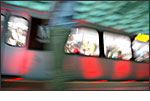 |
 |
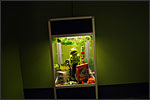 |
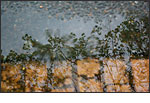 |
Click on thumbnails to view sample photos.
next page – Pentax K200D Conclusion >>


Pingback: A Photographer At The Beijing Olympics
Is there an image available of the special editon white model? Is it even available yet?
does anyone know the battery life as it says it takes AA batteries
The Rechargeable Batteries , Do Not Last Long in the K200D , even with the Ni-MH .
Pentax Reconmends to Use Lithium AA 4 Pack , which is going to set you back about $15 -$20
But they will take up to 1500 to 2500 pictures .
If You Do use Ni-MH , Used the Duracell Ni-MH ,
I have a few different brands AA Ni-MH ,and was Duracell is the Best Performer .
( And ,No ! I am Not Getting Any Comission )
I Have Own Canon Digital Rebel and the Nikon D50
I Presently Own a Pentax K200D ,due to the Price and the Weather Proofing , i wasn,t Expecting Much From this Camera , But It Surprised Me .
The Pentex K200D Falls in Between the Two , and You Have to Read Your Manual
Or Go on Youtube , and Search it out . Some Good Tips .
The ability to use AA batteries is key to me, as I tend to keep cameras for a long time and I want to know that this new camera will still be usable ten years from now.
And FWIW, good luck finding proprietary battery packs and/or proprietary chargers — just 5 years after you buy your proprietary dSLR.
I had this camera for a year now and I been able to use my old lens with out any problems from my film cameras. I do head shots and I also cover special events and family event and I love this camera. I find it hard to pick up my Film Pentax cameras and even My bronica. Since my bronica is Medium form time to time I still use it. The result are unreal excellent. I even used a flash head from my film camera and put it on auto and it work great. I was afraid at 1st to damage my electronic on my digital. But I got great result. I will buy a dedicate flash soon. But is nice to have a back up.
As a make up artist I like to get detail work on print and this camera is awesome.
I purchase Metz 48AF-1 Digital and a LumiQuest quick bounce and loving my result even more